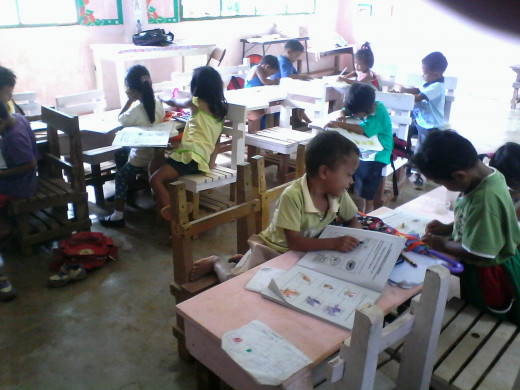Addressing Disruptive Behavior of Pupils through Teacher-Computer Instruction

Rationale
Many problems that students experience are normal responses to stressful events in their lives. These problems are generally temporary. However, the difficulties of students with behavior disorders make it impossible for them to complete fundamental tasks, such as acquiring skills and interacting with teachers or classmates. Include such problems are aggressive or disruptive behavior, going out from classroom during classes, noisy, aggressive and unfocused.
These problems disrupt and interfere with the teaching and learning process.
In relation to the goal of the K to 12 curriculum, the development of learners cognitive competencies and skills must be complemented by the formation of their values and attitudes anchored on the Core Values as stipulated in Department of Education ( DepEd )Order No. 36, s. 2013 .The school shall provide a nurturing environment and find ways to manage the disruptive behavior of pupils needing it.

School Performance Background
Mimbuli Elementary School is a non- central school in Salay District, Salay, Misamis Oriental , Philippines , topographically located approximately 3 kilometers from the national highway. The school is distance away from the center of the barangay . It is composed of eight (8) teachers including the School Head with 224 pupils from Kindergarten to Grade six (6) enrolled for the School Year 2019-2020.
The Most Common Disruptive Behavior Problem of Pupils
Because there are only few number of pupils enrolled in the school, I choose 37 respondents randomly selected for the purpose of identifying the most common disruptive behavior among pupils starting from grade 1 to grade 6. and the result of individual teachers query Among the common disruptive behavior problems that the teachers listed are the following :
1. Absenteeism
2. Dependent
3. Quarrelsome
4. Does not finish work on time
5. Inattentive
6. Uncooperative
7. Does not follow rules
8. Noisy
9. Escape from classes
10. Gallivanting

What is next?
After taking all the consideration and the problem identified , the next step is to validate the issue, I conducted a pre- test to find out what disruptive behavior is most dominant. This test was given to selected respondents randomly selected and they were supervised to take the test.
With all considerations above, I temperately evaluate the real score.
What I got from them? Here are the result
Twenty- eight out of thirty- seven respondents (more than 75%) answered never
they had absences from the start of the school year.
Eight out of thirty- seven respondents (more than 21 %) claimed that sometimes
they commit absences.
Zero out of thirty- seven respondents had not claimed always absent.
Fifteen out of thirty- seven respondents (more than 40%) claimed that never they
are dependent to classmates.
Thirteen out of thirty- seven respondents (more than 35%) claimed that
sometimes they are dependent
Ten out of thirty- seven respondents (27%) claimed that they are always dependent to classmates.
Eight out of thirty- seven respondents (more than 21%) answered never did they
have not finish activity on time.
Eighteen out of thirty- seven respondents (more than 48%) claimed sometimes
they did not finish work on time.
Eleven out of thirty- seven respondents (more than 29%) claimed that always
they did not finish work on time.
Twenty- two out of thirty seven respondents (more than 59%) claimed that never
they are quarrelsome.
Ten out of thirty- seven respondents (27%) claimed that sometimes they are
quarrelsome.
Six out of thirty- seven respondents (more than 16%) claimed that always they
are quarrelsome.
3
Seven out of thirty- seven respondents (more than 18%) claimed that never they
are inattentive.
Eighteen out of thirty- seven respondents (more than 48%) claimed that
sometimes they are inattentive.
Fourteen out of thirty- seven respondents (more than 37%) claimed that always
they are inattentive.
Seventeen out of thirty- seven respondents (more than 45%) claimed that never
they are uncooperative.
Fourteen out of thirty- seven respondents (more than 37%) claimed that
sometimes they are uncooperative.
Eight out of thirty- seven respondents (more than 21%) claimed that always they
are uncooperative.
Nine out of thirty- seven respondents (more than 24%) claimed that never did
they do not follow classroom rules.
Sixteen out of thirty- seven respondents (more than 43%) claimed that
sometimes they do not follow classroom rules.
Ten out of thirty- seven respondents (27%) claimed that always did they escape
from classes.
Fourteen out of thirty- seven respondents (more than 37%) claimed that never
did they escape from classes.
Fifteen out of thirty- seven respondents (more than 40%) claimed that
sometimes they escape from classes.
Five out of thirty- seven respondents (more than 13%) claimed that always they
escape from classes.
Six out of thirty- seven respondents (more than 16%) claimed that never did they
make noise during classes.
Nineteen out of thirty- seven respondents (more than 51%) claimed that
sometimes they are noisy.
Ten out of thirty- seven respondents (27%) claimed that always they are noisy.
Fifteen out of thirty- seven respondents (more than 40%) claimed that never did
they are gallivanting.
Fourteen out of thirty- seven respondents (more than 37%) claimed that
sometimes they are gallivanting.
Seven out of thirty- seven respondents (more than 18%) claimed that always
gallivanting.
The possible solutions
After validating the result of the test, I come to realize that not all of the efforts of teachers around the classroom are being paid. There are many interventions that must be readily available to cater the needs of children , specifically their interest . Here are some of " must do " interventions to be given to address the problem,
1. Pupils must be given intervention activities.
2. Pupils understand the lesson if teacher use computer presentation in
delivering the lesson.
3. Teachers should make use of effective Instructional Materials as an
attention –getting aid.
4. Pupils need extra time for value formation.
Strategy to be used
Based on the data, the I come up to the idea of finding activities that can help modify this behavior into a positive one which can lead their interest in the lesson.
Providing the pupils with intervention through facilitating ICT integration or Computer- based lessons in helping students how to behave appropriately and complete the teacher –given tasks.
The Strategy to be used are:
1. Computer – Teacher Instruction –Researcher will facilitate ICT integration to the lessons. This instruction is attention-getting aide to help maintain pupils’ interest. Include this instruction are lessons in a form of games.
2) Parent – Teacher Feed backing – conduct and interview with parents about the performance of their children at home.
There would be an agreed plan for feed backing to follow-up the child’s performance.
This study aims to gain pupils interest in every given tasks that could possibly improve pupils performance level in the class.

© 2020 Cynthia







